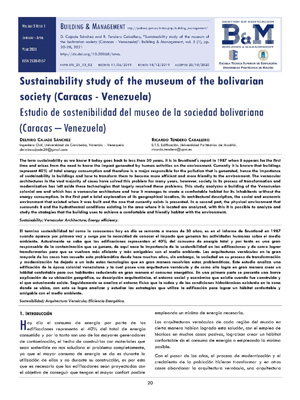
Sustainability study of the museum of the bolivarian society (Caracas - Venezuela) = Estudio de sostenibilidad del museo de la sociedad bolivariana (Caracas – Venezuela)
DOI: https://doi.org/10.20868/bma.2021.1.4701
Texto completo:
PDFResumen
Abstract
The term sustainability as we know it today goes back to less than 30 years, it is in Bruntland's report in 1987 when it appears for the first time and arises from the need to know the impact generated by human activities on the environment. Currently it is known that buildings represent 40% of total energy consumption and therefore is a major responsible for the pollution that is generated, hence the importance of sustainability in buildings and how to transform them to become more efficient and more friendly to the environment. The vernacular architectures in the vast majority of cases have solved this problem for many years, however, society in its process of transformation and modernization has left aside these technologies that largely resolved these problems. This study analyzes a building of the Venezuelan colonial era and which has a vernacular architecture and how it manages to create a comfortable habitat for its inhabitants without the energy consumption. In the first part a brief explanation of its geographical location, its architectural description, the social and economic environment that existed when it was built and the one that currently exists is presented. In a second part, the physical environment that surrounds it and the hydrothermal conditions existing in the area where it is located are analyzed, with this it is possible to analyze and study the strategies that the building uses to achieve a comfortable and friendly habitat with the environment.
Resumen
El termino sostenibilidad tal como lo conocemos hoy en día se remonta a menos de 30 años, es en el informe de Bruntland en 1987 cuando aparece por primera vez y surge por la necesidad de conocer el impacto que generan las actividades humanas sobre el medio ambiente. Actualmente se sabe que las edificaciones representan el 40% del consumo de energía total y por tanto es una gran responsable de la contaminación que se genera, de aquí nace la importancia de la sostenibilidad en las edificaciones y de como lograr transformarlas para que se vuelvan más eficiente y más amigables con el medio ambiente. Las arquitecturas vernáculas en la gran mayoría de los casos han resuelto esta problemática desde hace muchos años, sin embargo, la sociedad en su proceso de transformación y modernización ha dejado a un lado estas tecnologías que en gran manera resolvían estas problemáticas. Este estudio analiza una edificación de la época colonial venezolana y la cual posee una arquitectura vernácula y de como ella logra en gran manera crear un hábitat confortable para sus habitantes reduciendo en gran manera el consumo energético. En una primera parte se presenta una breve explicación de su ubicación geográfica, su descripción arquitectónica, el entorno social y económico que existía cuando fue construida y el que actualmente existe. Seguidamente se analiza el entorno físico que la rodea y de las condiciones hidrotérmicas existente en la zona donde se ubica, con esto se logra analizar y estudiar las estrategias que utiliza la edificación para lograr un hábitat confortable y amigable con el medio ambiente.
Sostenibilidad; Arquitectura Vernácula; Eficiencia Energética.
Palabras clave
Referencias
Ramírez, Aurelio. La construcción sostenible. https://www.cofis.es/pdf/fys/fys13/fys13_30-33.pdf
Quijada Mata, Jesus Manuel. 2017. Arquitectura colonial venezolana. Caracas – Venezuela.
Sánchez Góngora, José Francisco. Arquitectura Vernácula. 2005. Universidad de San Carlos de Guatemala.
Enlaces refback
- No hay ningún enlace refback.
Copyright (c) 2021 Autor / BY-NC-ND

Este obra está bajo una licencia de Creative Commons Reconocimiento-NoComercial-SinObraDerivada 4.0 Internacional.










